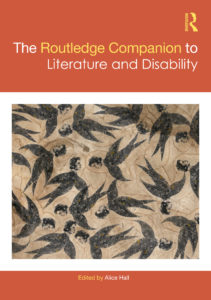
Cover of The Routledge Companion to Literature and Disability
Professor of English Chris Foss has published a book chapter entitled “‘Here There Be Monsters’: Mapping Novel Representations of the Relationship between Disability and Monstrosity in Recent Graphic Narratives and Comic Books” in The Routledge Companion to Literature and Disability, a significant new collection of essays edited by Alice Hall that according to the press “brings together some of the most influential and important contemporary perspectives in this growing field” of disability studies. Notable names among the contributors include Elizabeth Donaldson, Chris Gabbard, Leon Hilton, Petra Kuppers, David Mitchell, Michael Northen, Sami Schalk, and Jess Waggoner.
Foss’s chapter argues that three recent comics texts each present an instructive range of ambiguous, disabling, but above all enabling possibilities where the nexus of disability and monstrosity is concerned: the highly praised comics collections Monstress [Volumes 1 and 2] by Marjorie Liu and Sana Takeda (2016-17), the much ballyhooed debut graphic novel My Favorite Thing is Monsters [Book One] by Emil Ferris (2017), and the unheralded four-page Monster Girl comic by Helene Fischer (2017). These texts offer an illuminating starting point for the further exploration of the metaphorical assumptions about disability and monstrosity with which they engage, all the while reaffirming the crucial role of the genre’s own hybridity in foregrounding such considerations. That is, the location of the monstrous body in this particular textual format offers a range of diverse possibilities for both reinforcing and exploding the normative borders that have been constructed to define what is monstrous as dangerous/deformed/diseased. What is more, these texts encourage an intersectional approach to how multiple other facets of the monstrous (such as class-based/socioeconomic, ethnic/racial, and gendered/sexual aspects) overlap with disabled monstrosity and together blur, cross, deconstruct, and/or erase numerous lines along their various borders around the human.